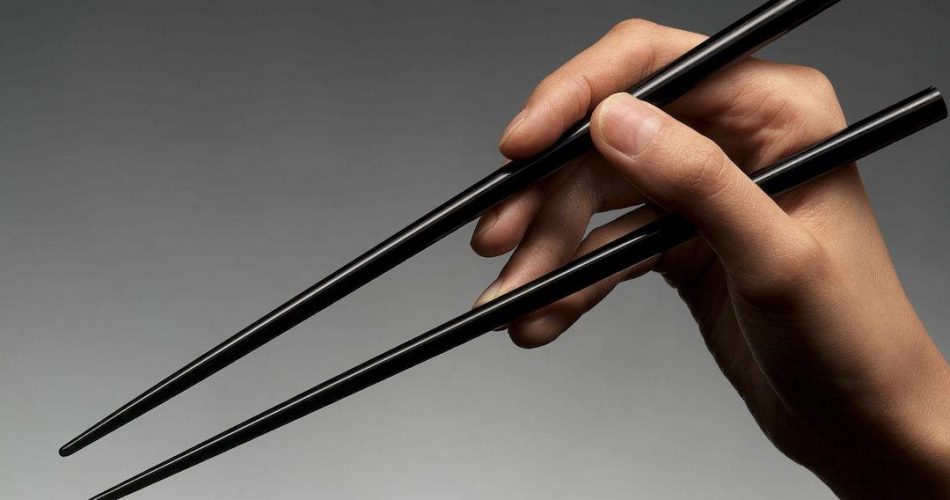Why do Westerners use knives and forks for their meals, while Chinese people use chopsticks for eating? This article will give you the answer and tell you how to use chopsticks and the etiquette in using chopsticks for eating.
Table of Contents
- 1. The history of chopsticks
- 2. Why do Chinese People Use Chopsticks instead of Spoons and Knives and Forks?
- 3. How to Use chopsticks?
- 4. What are the Rules for Eating with Chopsticks? (10 Rules)
- 5. The Cultural Meanings of Chopsticks
- 6. How are Chinese Chopsticks Different From Those of Other Asian Countries?
- 7. How to Buy Chinese Chopsticks?
- 8. FAQ about Chinese Chopsticks
1. The history of chopsticks
When Were chopsticks Invented and How Were Chopsticks Invented?
It is no exaggeration to say that more than 1.5 billion people use chopsticks worldwide, which means that one out of every five people eats with chopsticks. Chopsticks are arguably the most important tableware in Chinese food culture.
It is essential and necessary for children in every Chinese family to learn how to use chopsticks. According to a survey conducted by the University of Hong Kong, the average age at which children in Hong Kong can basically use chopsticks to finish a meal on their own is 4.6 years old.
In Chinese food, it is difficult for one to find a more convenient utensil than chopsticks. Apart from soup and drinks, chopsticks can be used for almost all kinds of dishes, from peanuts to barbecue pork buns.
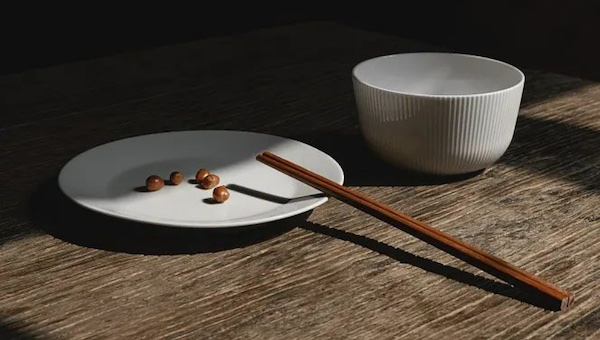
It is said that eating with chopsticks is “engraved in the genes” of the Chinese people. For thousands of years, China has developed a unique “chopstick culture”.
When Were Chopsticks Invented and Put into Use?
It was about 7,000 years ago.
A number of sticks of varying lengths, usually made of animal bone, have been unearthed at Neolithic sites throughout China, such as Longzhuang in eastern Jianghuai and Qinghai. Some archaeologists refer to these short bone sticks as “bone chopsticks”, which are likely the predecessors of chopsticks.
In published monographs on the history of chopsticks (such as A Cultural History of Chinese Chopsticks edited by Liu Yun), it has been pointed out that the prototype of chopsticks appeared in China as early as 5000 B.C. Thus, it was predicted that Chinese people began using chopsticks at least during the Neolithic period. There is nearly a history of 7,000 years of chopsticks in China.
The earliest archaeological discovery of chopsticks was made in a late Shang Dynasty tomb at Yinxu in Anyang, where archaeologists found six copper chopsticks in tomb number 1005, which are thought to have been prepared for eating. Therefore, it is believed that chopsticks were used as tableware in the Shang Dynasty.
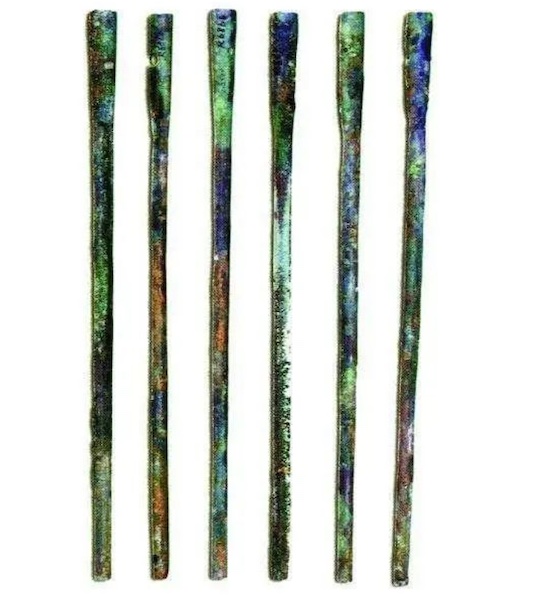
In addition, the story of King Zhou of the Shang Dynasty making chopsticks from ivory is recorded in The Records of the Grand Historian by Sima Qian of the Western Han Dynasty and Han Feizi of the pre-Qin Dynasty.
However, by this time, it was found that chopsticks were made from such a precious material as ivory, meaning that they had already undergone a long development before King Zhou of the Shang Dynasty.
The Evolution of the Names for Chopsticks
Chopsticks were called “jiā” (“梜” in Chinese) in the pre-Qin Dynasty, “zhù” (“箸” in Chinese”) in the Han Dynasty, and “Kuài” (“筷” in Chinese) from the Ming Dynasty. All the three Chinese characters mean chopsticks.
In the Book of Rites, it indicates that if there is food in the soup, people should use “jiā” (“梜” in Chinese) to eat it, and if there is no food, people don’t need “jiā” (“梜” in Chinese).
However, the name “jiā” (“梜” in Chinese) was rather out-of-the-way at that time, so the name “chopsticks” emerged later, and was even used for a long time in Chinese history. Nevertheless, today, the ancient name of chopsticks, “jiā” (“梜” in Chinese), is still being used in many areas of southwest China.
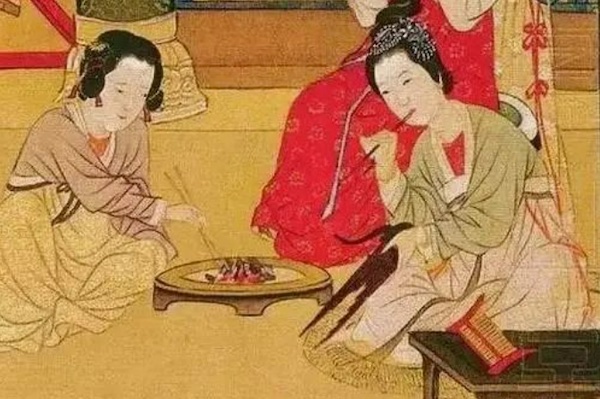
So why did the name for chopsticks change from “zhù” (“箸” in Chinese”) to “chopsticks” later on? This originates from the ancient Chinese culture of avoidance.
Avoidance was very important in ancient China. It meant to pay attention to the honored and the sage. That is to say, common people should avoid being too close to noble, wise, and capable people.
The same is true for the avoidance of chopsticks, the change of the name from “zhù” (“箸” in Chinese”) to chopsticks occurred in the Ming Dynasty.
2. Why do Chinese People Use Chopsticks instead of Spoons and Knives and Forks?
Since the history of chopsticks in China dates back to 7000 years ago, were chopsticks always the major tableware for ancient Chinese meals?
The answer is “No”.
So, were knives and forks the main tableware of the ancient Chinese? Yes, that’s right, the Chinese used knives and forks instead of chopsticks in the beginning, and you may not know that it was also the Chinese who first used knives and forks.
In China’s Qinghai Zongri site, a bone dinner fork of Majiayao culture was unearthed, with a length of 25.7 cm, three teeth, and 9 cm long teeth.
Subsequently, a bone dinner fork about 4,000 years ago was unearthed in the Qijia culture site in Gansu, after which 51 pieces of bone dinner forks from the Warring States period were unearthed at one time in Luoyang, Henan Province, all with double teeth and round handles, about 12 cm; and the earliest cutlery knife found in the world was found in the Hemudu site in Zhejiang Province, China, 7,000 years ago.

So why did the Chinese gradually change from using knives and forks to chopsticks as the main tableware?
This lies in the development of Chinese food culture.
Before the farming culture grew mature, the main production method of Chinese people was hunting. After hunting, the prey was naturally cut with a knife, and then fork was inserted for roasting. So the major cutlery at that time were knife and fork.

Before the Qin Dynasty, the noble class was also called “meat-eaters”, and the fork was used by them to eat meat. So the fork was exclusively used by the ancient aristocracy, and the vegetarian “patchouli-eaters” simply did not use it.
After the Warring States, dinner forks rarely appeared. Because pottery was already available at that time, people liked to cook and eat with pottery.
In the earliest times, people threw grains such as “millet” into the pot together with vegetables and meat cut into small pieces. Regardless of ancestors’ preference for spoon, it was difficult to take meat out of soup with a fork.
Instead, it is obviously more appropriate to use a spoon with chopsticks, with the spoon being used to drink soup and the chopsticks to pick up meat and vegetables in the pottery, each in its own way.
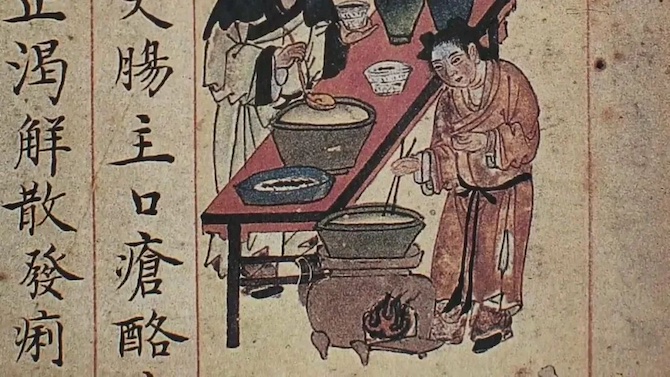
After the Han Dynasty, wheat gradually became the main crop in the northern region.
With the popularity of stone mills, which in turn could process wheat into pasta (noodles, dumplings, etc.), chopsticks had different strengths.
Stone mills could also be used to grind rapeseed and other vegetable seeds, turning them into edible oil.
The advent of cooking oil after the Han Dynasty directly brought a new cooking style of stir-frying. Stir-frying was often involved in cutting food to a predetermined size, and chopsticks were used to pick up such food more precisely and easily than a table spoon.
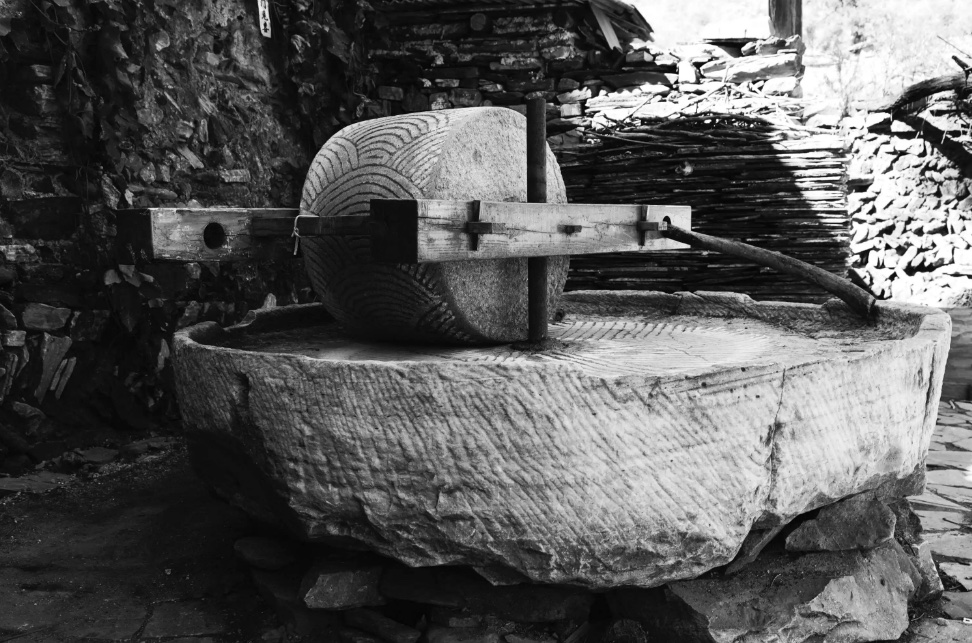
Besides, traditional habits of communal eating delivered chopsticks to be the main tableware in China.
With the collective agricultural civilization of ancient East Asia, the tradition of collective eating was formed. Chinese people also eat in groups, and ingredients were usually processed by chefs into shapes suitable for use (such as mahjong-shaped pieces or slices), so that diners could easily pick them up.
Thus, when two long and thin sticks were held in the hand, they could be picked, plucked, and grilled through the deft movement of people’s fingers, and such chopsticks were perfect to eat different kinds of food.
Apparently, as the food of Chinese evolved and their eating habits changed, chopsticks eventually replaced knives, forks, and spoons as the dominant tableware in the ancient Chinese diet.
3. How to Use chopsticks?
People have found the convenience of chopsticks after they master the way to use them.
So what is the right way to use chopsticks in China?
When people use chopsticks, there is also a posture to follow. The correct way to hold chopsticks is to hold the upper end of the chopsticks with the thumb and index finger, while the ring finger and pinky finger are underneath and the middle finger is in the middle. These three fingers are naturally bent, one moving and one from the other, making excellent use of the principle of leverage.
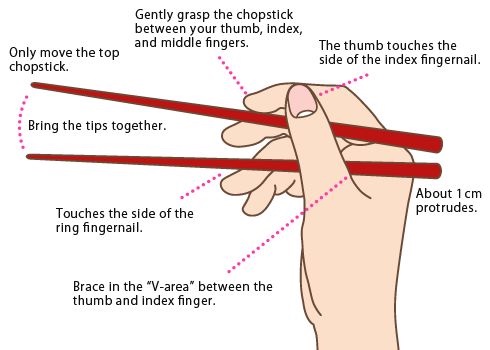
Three Tips for Holding Chopsticks Correctly:
1) Hold the chopsticks about one-third of the way from the top of the chopsticks, not too high nor too low.
2) When people clamp things with chopsticks, except for the heads of the chopsticks touching each other, all other positions should be parallel, not crossed and “twisted”.
3) Make chopsticks with the palm of your hand facing upwards at 45 degrees. Why? Because if you put your palm downward, you will have to turn your hand over to eat the food after you pick it up.
4. What are the Rules for Eating with Chopsticks? (10 Rules)
Etiquette is of vital importance in China, and the etiquette of using chopsticks is a symbol of manner at the Chinese table.
At the table, the Chinese pay much attention to the way they hold chopsticks and the direction they are placed. Even in ancient times, there were rules about which chopsticks were used for food eating.
In the Book of Rites – Qu Li Shang, it is said that “rice and millet should not be eaten with chopsticks”, meaning that one should not use chopsticks when eating rice but use a spoon. Only when there is food in the spoon should you use chopsticks to eat it.
Mr. Cai Yuanpei once said, “A person who uses chopsticks gracefully in China has an extremely high probability of becoming a gentleman when he leaves the table.”
What do you need to pay attention to when using chopsticks? Here are some rules.
Top 10 Rules for Using Chopsticks at the Dinner Table:
(1) Chopsticks must be placed neatly, not in different lengths on the table. People should not move them back and forth among the plates or turn around on the plates without picking up the food.
2. In ancient China, only beggars used to hit the rice bowl with chopsticks; when sitting around a table, you should not only eat by yourself, but also take care of other people’s feeling. For instance, you should use public chopsticks to serve food to others; and the younger generation should wait for the elder before eating with chopsticks.
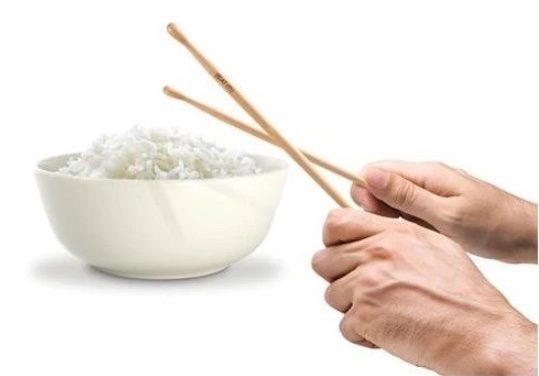
3. On formal occasions, if chopsticks are placed horizontally on a bowl or plate, it means “I’m drunk and full, so I won’t eat anymore and ask others to enjoy their meal”.
In other places, if the chopsticks are placed on the left side of the bowl, it means that you have eaten enough.
4. You should not use “vertical chopsticks”. To “stand up” means to place your chopsticks directly on top of the rice in the bowl or the food on the plate.
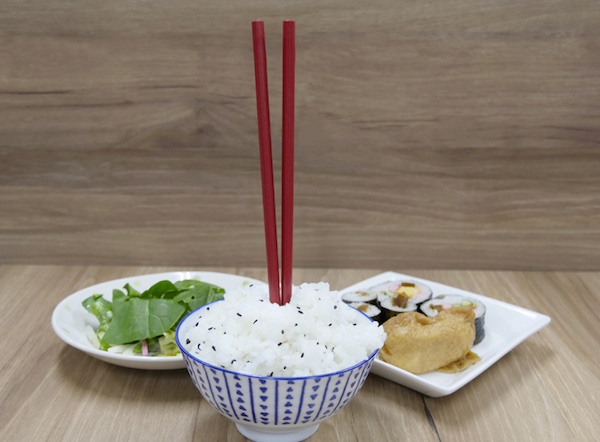
The rule at the dinner table is that chopsticks should only be placed flat. It is very unlucky to have chopsticks standing up, which works like burning incense on the table.
According to Chinese traditions, incense is often offered for the dead, so if you stick your chopsticks in the rice, you are undoubtedly treating the other person as if he or she were dead, which may cause miscomfort or conflicts.
5. Avoid “三长两短” (literal meaning: “three long two short”; paraphrased meaning: “unexpected misfortune” in English). It means that before or during the meal, the chopsticks are placed on the table with different lengths, which is inauspicious and conveys the meaning of “death”.
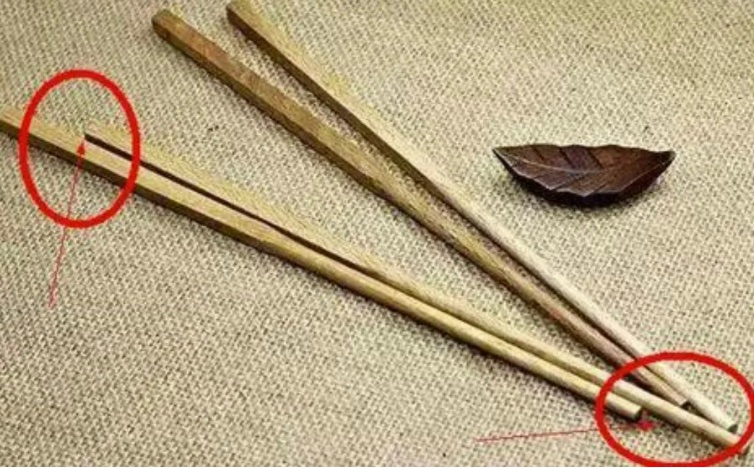
6. Avoid “fairy pointing”. This refers to a gesture to hold chopsticks with the thumb, middle finger, ring finger and little finger pinching the chopsticks while the index finger is extended.
As the index finger sticks out, it seems that you are using the chopsticks to point at others, which may mean accusation.
Therefore, pointing your finger at someone while eating with chopsticks is the same as accusing him or her, which is the same as cursing, so it should be avoided.
7. Do not “sip the chopsticks and give off sound”. This is the practice of holding one end of the chopsticks in your mouth and sip them with your mouth, making a sizzling sound from time to time. This practice is generally considered to be a lack of manners.
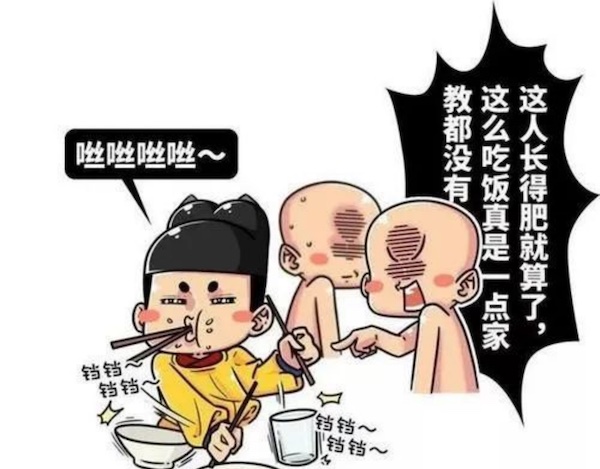
8. Avoid “using chopsticks to dig the grave”. This refers to a gesture to hold chopsticks in your hand and constantly pull them around in the dish, turning them left and right to find meat, just like digging a grave. This practice is rude and annoying.
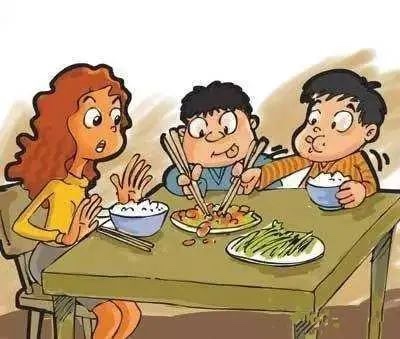
9. Don’t “turn your chopsticks upside down”. This means not to use the chopsticks upside down when eating. As the saying goes, when the chopsticks are upside down, it means a decline in family fortune. Hence, it is not advisable to hold chopsticks in this way.
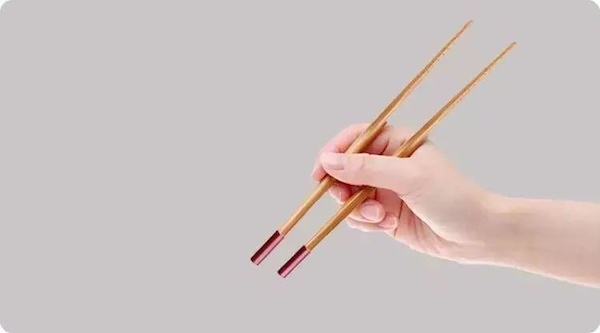
10. Do not “cross your fingers”. This refers to a behavior to place chopsticks on the table in a random cross during a meal, which is also wrong. The Chinese believe that to cross one’s chopsticks at the table is to deny others at the table and to disrespect oneself.

These are some essential principles in using chopsticks. Behind a pair of seemingly simple chopsticks lies Chinese “rules” about eating and “reasoning” about being Chinese.
5. The Cultural Meanings of Chopsticks
As a necessary tableware at the Chinese table, chopsticks involve profound Chinese cultural significance, and they are also a symbol of Chinese civilization.
After a long period of development, chopsticks have gradually developed with a round head and a square tail.

The rounded head and square tail imply the meaning of “Heaven and Earth”, and also contain the meaning of “Yin” and “Yang” (the two opposing principles in nature, the former meaning feminine and negative and the latter meaning masculine and positive).
In the process of using chopsticks to hold food, these two chopsticks, one moving and one not moving, highlighting the harmony of “Yin” and “Yang”, which is the philosophical wisdom of the Chinese.
In addition, the two ends of the chopsticks also represent the two trigrams of heaven and earth.
Also, why are chopsticks called “one pair” when there are two of them?
This is because, in traditional Chinese culture, people consider “a pair” (two well matches) a symbol of goodness, completeness, and doubling of blessings. People often say that good things come in pairs, and “double” means in pairs.
Red chopsticks also play an integral role in the wedding of a Chinese couple. The two chopsticks together symbolize “two woods that become a forest, accompanying each other forever” (as chopsticks are made from wood), signifying a perfect union.

Therefore, people also use the term “one pair” instead of “two” for chopsticks.
In China, the standard length of chopsticks is seven feet and six inches, representing seven kinds of emotions and six types desires of human beings.
The seven kinds of emotions are joy, anger, sorrow, fear, love, evil and desire, while the six types desires are the desires of people’s eyes, ears, nose, tongue, body and mind.

In addition, chopsticks convey the good wishes of people for collaboration and the win-win situation, sharing happiness and hardship, honesty and harmony, happiness and peace, and success.
Since ancient times, chopsticks have been used as gifts and a tool to convey people’s emotions. Currently, chopsticks can also be used as gifts.
6. How are Chinese Chopsticks Different From Those of Other Asian Countries?
As mentioned earlier, at least 1.5 billion people in the world today use chopsticks for meals. This also means that not only are Chinese people using chopsticks, but also other countries are using chopsticks as tableware.
Of course, chopsticks are mainly used by some countries in East Asia. Chopsticks originated in China, and they are used by a small number of countries in the Chinese cultural circle.
In some countries, chopsticks are the main tableware as they are in China, while in other countries, tableware is chosen in line with the characteristics of food. That is to say, chopsticks are just one of the tableware.
At present, chopsticks are used as the main tableware in Korea, Japan, North Korea and Vietnam. In other countries like Malaysia, Singapore and Mongolia, chopsticks are used when people eat Chinese food. For example, Thais only use chopsticks when eating noodles and rice noodles.
So, what are the differences between the chopsticks used in China, Japan, and Korea? How do you identify Chinese chopsticks?
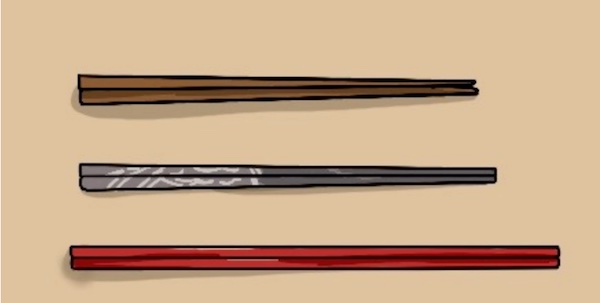
1) Chinese Chopsticks
Chopsticks, originating from China with a history of at least 5,000 years, are made of many materials, mostly wood and bamboo. Most Chinese chopsticks are around 25cm in length, the longest among countries using chopsticks.

There are a variety of Chinese dishes with diversified cooking methods.
Chinese home cooking is mostly characterized by much oil, therefore, Chinese people mostly use wooden and bamboo chopsticks instead of metal chopsticks to prevent dishes from slipping off during the clamping.
The reason why Chinese chopsticks are the longest lies in that in the Chinese culture, Chinese people often sit around a large round table for dinner with a variety of dishes, and everyone uses chopsticks to pick up the dishes they want to eat.
Therefore, to pick up the meals far away from them, Chinese tend to use long chopsticks.
Chinese chopsticks are designed with a square end and a round end, which is practical in the sense that the round end will not hurt the mouth, while the square end is stable and does not slip off.
It also corresponds to the ancient Chinese idea that ‘Heaven and earth are round and “Yin” and “Yang” are in harmony’.
2) Japanese Chopsticks
Chinese chopsticks were introduced to Japan via the Korean Peninsula in China at the end of the Yayoi period. Japanese chopsticks are mostly made of wood and are very short with a thick tail at the tip.
Japanese people mostly eat “set meals”, which are single-serving meals. Even at home, Japanese people serve meals individually, so they have shorter chopsticks.
The design of wooden chopsticks with pointed ends and thick tails is related to resource allocation and the characteristics of food in Japan. In Japan, there are very limited mineral resources, but the woods are abundant, so chopsticks are mostly made of wood.
On the one hand, the pointed end of the chopsticks makes it easier to hold small foods such as sushi. On the other hand, the pointed end makes it easier to pick out the fish.

There are also different types of chopsticks for different types of food in Japan. For example, silver chopsticks are used for appetizers, bamboo chopsticks for rice, real fish chopsticks for eating fish, vegetable chopsticks for eating vegetables, children’s chopsticks for children, and guest chopsticks for guests.
3) Korean Chopsticks
It seems that chopsticks were used in Korea a little earlier than in Japan, and before chopsticks were introduced to Korea, spoons were commonly used.
Unlike Chinese chopsticks, which are mostly made of wood or bamboo, Korean chopsticks are flat and heavy metal chopsticks.
So why are Korean chopsticks metal chopsticks? There are several reasons.
One is that the north of Korean peninsula is rich in metal minerals and it is easier to make metal chopsticks, which is probably the reason why metal chopsticks are still popular until now in this country.
Secondly, most of the meals on the Korean table consist of soup, rice and small dishes. In the eyes of Koreans, chopsticks soaked in soup are unhygienic, so they use iron chopsticks. Since Koreans are fond of small dishes, these iron chopsticks are also very convenient for tearing or picking up such dishes as radish and kimchi.

In addition, Koreans also prefer to eat barbecued meat. When they clip the dishes on the baking tray, the temperature of the tray is high. The iron chopsticks boast the feature of high temperature resistance, so Koreans choose metal chopsticks.
So, after understanding the differences between Chinese, Japanese and Korean chopsticks, you know what Chinese chopsticks are?
7. How to Buy Chinese Chopsticks?
(1) Do not buy chopsticks coated with colored paint because the heavy metal lead and organic solvent benzene in the paint are carcinogenic and will fall off with wear and tear, thus causing harms to people’s body.
(2) Plastic chopsticks are brittle and are easily deformed and melted when heated, thus producing substances harmful to humans.
(3) Bone chopsticks have good texture, but they are easily discolored and are more expensive.
(4) Bamboo chopsticks are non-toxic and very environmentally friendly. Since most people cannot tell whether paint is healthy or not, it is recommended that you try to choose chopsticks without paint in their original color. Wooden chopsticks should be as dense and refined as possible in terms of the texture.
However, it is difficult to clean bamboo and wooden chopsticks and they can be easily contaminated by disease and microorganisms, so they should be disinfected frequently.
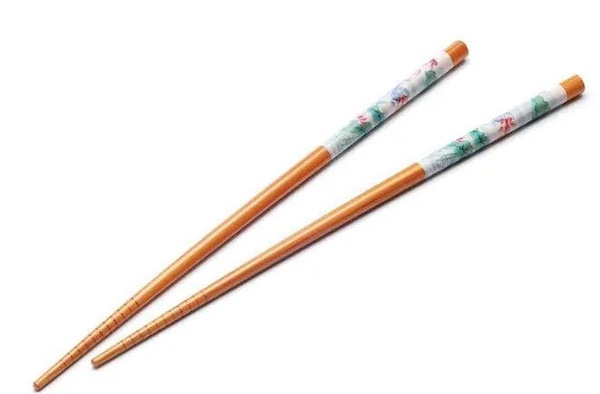
8. FAQ about Chinese Chopsticks
1. How Long are the Chopsticks?
Among the chopsticks of China, Japan and Korea, Chinese chopsticks are the longest, with most of them being about 25cm long, making it easy for Chinese people to eat at a large round table.
2. Besides Eating, What Else can Chopsticks be Used for?
Apart from being used for eating and picking up vegetables, chopsticks are also one of the most handy cooking tools in China, making the process of wrapping and stuffing dumplings and cooking noodles much easier and more efficient. In other words, chopsticks can be used for both eating and cooking.
Today, chopsticks are a versatile cooking utensil in many Asian kitchens, for example, to beat an egg or stir a meat mixture; they can also be used to pick up food in a pan to check its doneness or to taste it.
3. What are the Hidden Dangers of Using Bamboo and Wooden Chopsticks?
Helicobacter pylori, which causes gastric disease, is present in nearly 50% of the population, and most of these bacteria are spread at home, with chopsticks being one of the important channels of transmission.
Therefore, chopsticks should ideally be replaced every 3 to 6 months like a toothbrush. Chopsticks should only be boiled in boiling water at 100°C for more than 5 minutes for sterilization, and it is best to use a disinfection cabinet for this purpose.
The use of moldy chopsticks can induce liver cancer, and household chopsticks also have a shelf life, so it is best to change them every six months.
4. How Can I Identify Whether the Chopsticks can be Used Again?
(1) If there are spots on the chopsticks that are not the original color of bamboo or wood, it means that the chopsticks are moldy and deteriorated and should not be used.
(2) If the chopsticks appear damp, or are bent or deformed as they have been set aside for too long, you should not use them again.
(3) If there is a distinct sour smell, and the chopsticks are contaminated, do not continue to use them.
